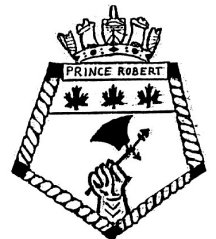
HILLMAN WWII SCRAPBOOK
HMCS PRINCE ROBERT
Presents
9. LOOKING BACK

9. LOOKING BACK
The ROBERT and her sister ships were more typical of the wartime Navy than any other. In a way, they symbolized its personnel. When the balloon went up, they shouldered their Naval burden – interrupting their chosen pursuits because there was need, and they were there. Some of their characteristics could be used to suit the ends of a Navy which believed a ship in the water is worth three on the drawing board. They mirrored the Officers and Men who were essentially civilians, hastily recruited in an emergency. At its peak strength, the RCN had nearly 100,000 personnel of which less than five percent were regulars. The ROBERT was like her crew who were, for the most part, volunteers and to whom the ways of war were but third nature, not second.
The ROBERT and the men who sailed in her, were ploughshares improvised to swords for the duration. Between the ship and the men there was thus a rapport that stemmed from a similar need to adapt. Original inexperience in Naval ways was overcome by willingness and enthusiasm and thus conquered.Since the Princes were the only big ships in a small Navy, they gave the RCN a modern look it would not otherwise have had. One of the aspects of Sea Power in World War II was the operation of aircraft in a dominant role. The ROBERT was the only ship in the RCN specifically and best equipped to meet this role.
In its earlier role as an AMC, and later as an A/A cruiser, the ROBERT gave greater balance to Canadian naval operations and more variety and interest to its annals. The use as a blockade unit, and later as an A/A cruiser, was an innovation for the RCN. The frontispiece illustrates the far-flung geography of the ROBERT’s operations which covered most of the navigable world.
To keep the record in perspective, there was much that was dull and routine and there was little hardship compared to North Atlantic corvettes. The men were warm and dry for the most part. Tactical burdens were not onerous. She was not rushed about without respite. A boiler clean could be had without threatening utter breakdown. Although liable to move in several directions, she was usually allowed to rest a bit in each theatre of operations. Pressures were fewer and hazards less. She saw a great deal of the war and rather less of the enemy. The ROBERT suffered little damage and few casualties but more of the war as a whole than other ships.
But the ROBERT provided Canada a naval entry onto wider stages than the North Atlantic. She generated good publicity abroad and helped keep NSHQ involved in the whole picture of global strategy. She showed the Canadian presence in ports which had never witnessed it before. She plugged gaps in the sea defences when there was no one else able to serve. In exotic oceans she built a naval tradition upon civilian foundations and she did it very well. The ROBERT covered the Maple Leaf with honour sufficient for her time. Her record, full of diverse and original assignments, strange encounters, and duty faithfully done, will long endure.
SOURCES:International Warships – March 1970 – Fraser McKee
Ships of Canada’s Naval Forces – McPherson and Burgess
Far Distant Ships – Schull
Maritime Museum – Victoria, B.C.
Royal British Columbia Museum, Victoria, B.C.
B.C. Provincial Archives
Harold Moist, Ex-Bosun, H.M.C.S. PRINCE ROBERT
W.B. Creary, ex C.O. H.M.C.S. PRINCE ROBERT
C.T. Beard, ex C.O. H.M.C.S. PRINCE ROBERT
G.R. Johnson, ex-Radar Officer, H.M.C.S. PRINCE ROBERTCopyright G.R. Johnson 1988
First published by VIP Graphic Studio – Sidney, B.C.







Webmaster: William G. Hillman
BILL & SUE-ON HILLMAN ECLECTIC STUDIO
Copyright 2000/2006/2017
Bill Johnson Material Copyright 1988